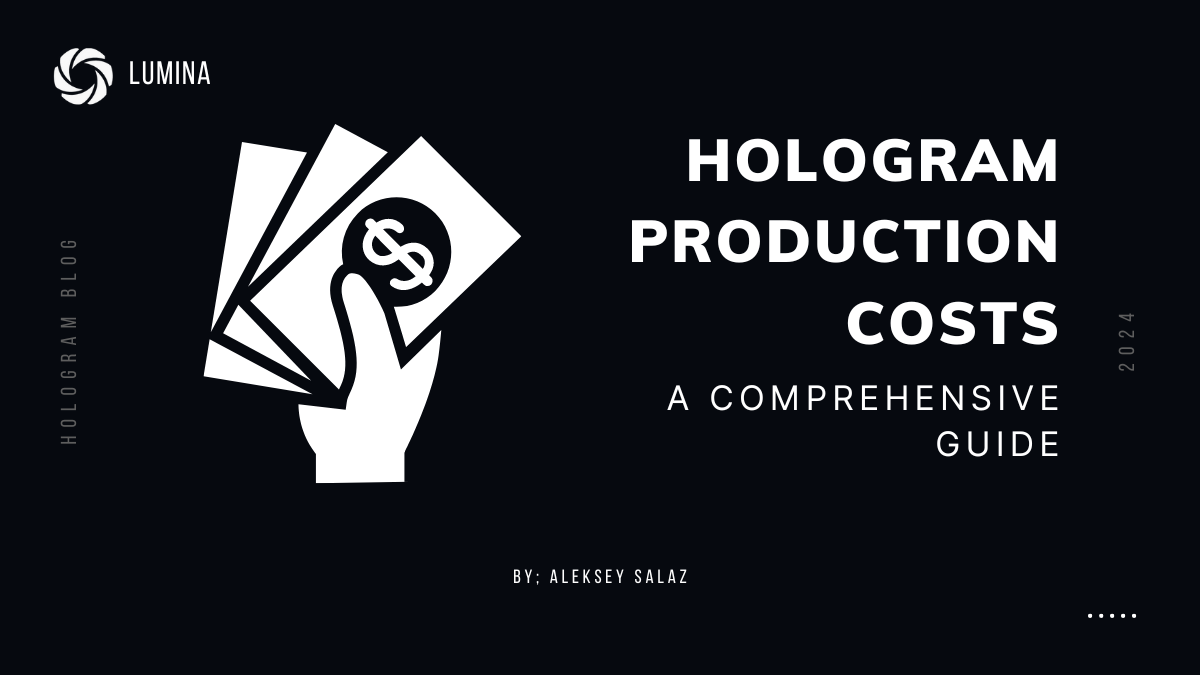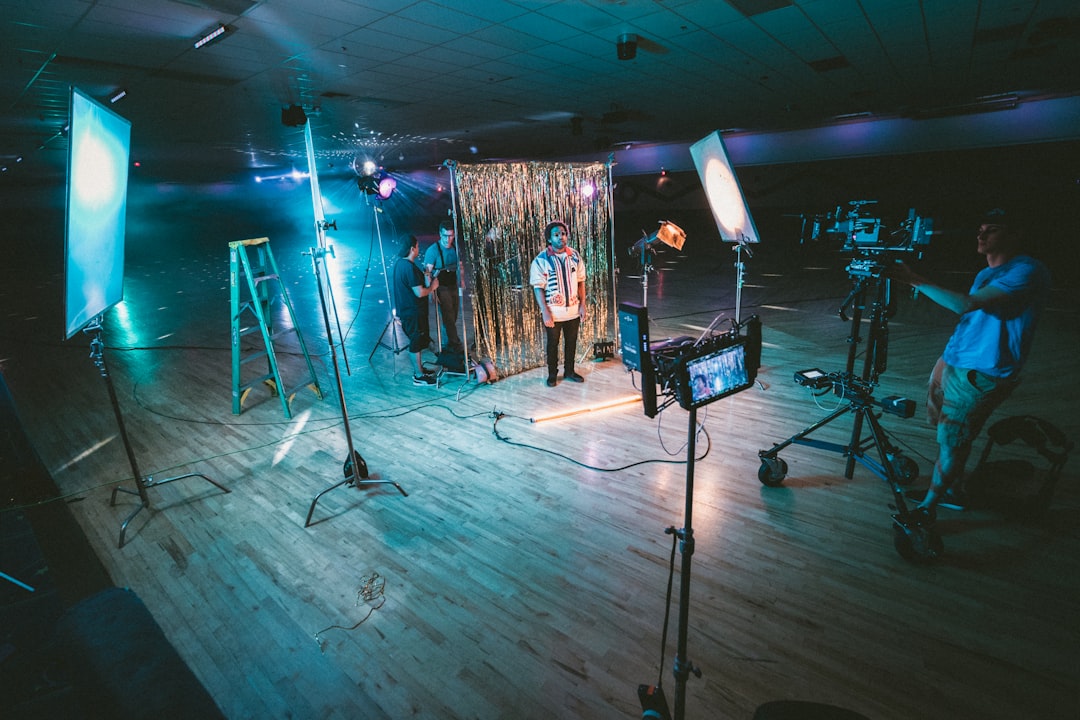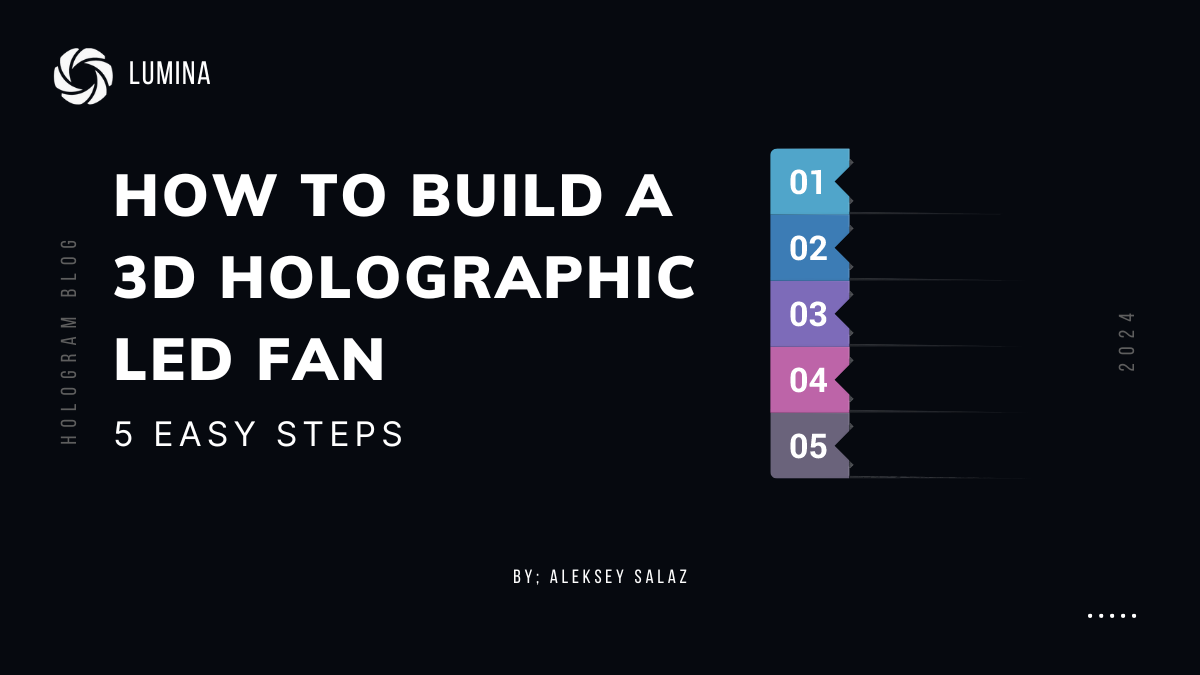Have you ever wondered about the price tag behind the captivating and immersive holographic displays you have seen at events or in retail stores? Well, the costs of creating such advanced and highly engaging visual experiences can range widely, influenced by a variety of factors including the size, quality, and features of the equipment used.
Based on the information we've researched and our expertise at Lumina:
- Entry-level hologram projectors, ideal for personal use or small-scale displays, typically start from $100 to $500.
- Mid-range projectors with higher resolution and more features suitable for small businesses, range from $500 to $2,000.
- Professional-grade projectors that deliver superior image quality and size often cost $2,000 to $10,000 or beyond, making them perfect for large-scale events and industry use.
That these figures represent just the cost of the projectors. Other essential elements such as production, content creation, and maintenance add to the total expense.
Despite the complex technology and relatively high costs involved, understanding holography can give us a glimpse into the future of visual communication, helping us to make more informed decisions when investing in high-tech advertising solutions.

The Science Behind Holograms
A hologram is a three-dimensional image created with photographic projection. It's not just an image but a detailed recording of a light field rather than of an image formed by a lens. It's a product of holography, a technique that allows light scattered from an object to be recorded and later reconstructed.
The Role of Light in Holography
Holography is all about light and its characteristics. Light behaves in two ways – as particles and waves. In the creation of holograms, we harness the wave characteristic of light. A beam of light hits an object, then scatters in different directions. These scattered light waves are what we capture in a hologram, hence the 3D effect.
The Use of Lasers in Creating Holograms
Lasers play a crucial role in holography. To create a hologram, we use two beams of laser light - the object beam and the reference beam. The object beam is shone onto the object, and the scattered light is captured on a photographic plate. The reference beam, on the other hand, is directed straight onto the photographic plate without hitting the object. The resulting interference pattern formed by the two beams on the plate creates the hologram. When the holography process is complete, the hologram can be viewed by illuminating the photographic plate with the reference beam. This produces a three-dimensional image of the object, which can be seen from different angles, giving a realistic visual experience.
The Pepper's Ghost Technique
The Pepper's Ghost technique is a popular method used in the creation of holograms. It's a simple yet effective technique that transforms an object or person into another. It creates the illusion of seeing something or someone appear from nowhere or disappear. This technique is commonly used in cinemas, amusement parks, museums, and many other places. It involves a setup with live characters and the main background in front of the audience and a "ghost" placed off to the side out of sight. A sheet of plexiglass is set at a 45-degree angle between the audience and the "ghost", reflecting the image of the "ghost" while leaving the background clearly visible. The result is a transparent "ghost" appearing in front of the audience.
All these processes and techniques are fundamental to how we create and use holograms. Understanding them helps demystify the question, 'how much does it cost to make a hologram', as these form the basic components of holography production costs.
The Cost of Creating a Hologram
Having unraveled the mysteries of hologram creation, let's dive into the main question at hand: how much does it cost to make a hologram?
Factors Influencing the Cost of Hologram Production
The cost to produce a hologram can vary greatly, depending on several factors:
Complexity and Quality: Detailed, high-resolution holograms require more resources and time to produce, increasing the cost. For instance, a simple hologram might cost a few hundred dollars, whereas a high-quality, intricate hologram can cost thousands of dollars.
Equipment and Technology: The use of cutting-edge technology and specialized equipment also influences the cost. This includes holographic display devices, cameras or scanners for capturing the subject's likeness, and digital processing tools.
Scale of Production: The quantity and size of holograms produced can also affect the cost. Producing large-scale or multiple holograms typically costs more due to the increased materials and labor required.
The Cost of Hologram Production for Personal Use
Entry-level holograms suitable for personal use or small-scale displays, such as those created by DIY hologram kits, are typically more affordable. These kits, which include necessary materials and step-by-step instructions, can range from $50 to $100. Some handheld hologram projectors for personal use can start from $100 to $300.
The Cost of Hologram Production for Commercial Use
Commercial-grade holograms, such as those used for advertising or events, are typically higher in quality and larger in scale, leading to higher costs. Mid-range projectors suitable for small businesses or educational purposes can range from $500 to $2,000. Furthermore, high-end models with superior image quality, larger size, and advanced features, ideal for large-scale events and professional settings, can range from $2,000 to over $10,000.
At Lumina, we offer a range of 3D holographic fans that provide a cost-effective way to produce high-quality, vibrant, and captivating holographic displays.
The Cost of Hologram Production for Celebrity Holograms
Producing a hologram of a specific individual, particularly a celebrity, can be quite costly due to the need for likeness rights and the complexity of creating a realistic representation. For instance, the infamous Tupac hologram reportedly cost at least $100,000.
In conclusion, while the cost to make a hologram can vary greatly, consider the purpose, quality, and complexity of the hologram to ascertain the most cost-effective solution.
The Process of Creating a Hologram
Now that we've explored the costs associated with hologram production, let's delve deeper into the process of creating a hologram. The creation of a hologram is an art and science, requiring careful planning, meticulous attention to detail, and expert execution.
The Role of DeepFake Technologies in Hologram Production
The advent of DeepFake technologies has significantly simplified the process of creating lifelike holograms. By utilizing machine learning and artificial intelligence, DeepFake can generate realistic images and videos, enabling the creation of holograms that closely resemble the original subject.
However, it's important to note that while DeepFake technology can reduce the cost of creating a hologram, it's not the only factor that influences the final cost. The complexity of the hologram, the quality of the equipment used, and the skill of the technicians involved all play a significant role in determining the final cost.
The Use of SFX, VFX, and Motion Tracking in Hologram Production
Special effects (SFX), visual effects (VFX), and motion tracking are three additional techniques extensively used in hologram production. SFX and VFX are used to create the illusion of depth and movement, making the hologram appear more lifelike.
Motion tracking, on the other hand, is used to capture the movements of the original subject, which are then replicated by the hologram. This technique is particularly useful when creating holograms of live performances or speeches, as it allows the hologram to mimic the original subject's movements accurately.
When creating a 3D hologram, the object to be holographed is illuminated with a laser beam. The light scattered from the object interferes with the reference beam, creating an interference pattern which is then recorded on a holographic film or a digital sensor. After the exposure, the holographic plate is developed in a chemical solution, solidifying the interference pattern into a visible hologram.
In summary, creating a high-quality hologram involves more than just following steps – it requires a dark room to avoid interference from external light sources, a clean setup, an environment free of vibrations, and a lot of patience. But the end result is a mesmerizing 3D hologram that can captivate audiences and create a lasting impression.
At Lumina, we are committed to helping you leverage this cutting-edge technology to stand out from the competition. Our team of experts is skilled in using the latest technologies, ensuring the creation of professional, high-quality holograms tailored to your specific needs.
DIY Hologram Kits: An Affordable Alternative
For those seeking a cost-effective introduction to holography, DIY hologram kits offer an excellent starting point. They provide a hands-on experience in creating holograms, making them a popular choice for educators, hobbyists, and businesses looking to explore the technology's capabilities.
What is Included in a DIY Hologram Kit
Typically, a DIY hologram kit will include all the essentials required for creating a hologram. This includes a laser source, which is the heart of a holographic system, and a holographic film or plate, which captures the light patterns to create a holographic image. The kit also features a beam splitter for dividing the laser beam, mirrors for directing the beams, and a stable platform for hassle-free operations.
In addition to these, many kits also provide step-by-step instructions and free technical support to assist you in your holography journey. 
The Cost of DIY Hologram Kits
When it comes to the question, 'how much does it cost to make a hologram,' DIY kits provide a budget-friendly answer. The cost of DIY hologram kits can vary based on the number of holograms you can create and the quality of the components included.
For example, a standard hologram kit capable of creating up to 30 holograms on glass plates can cost around $285. On the other hand, a student kit designed for learning purposes that can produce up to 12 holograms is priced at approximately $175. There is also a budget option available for around $145, which allows you to create up to 10 holograms on film sheets
How to Use a DIY Hologram Kit
Creating a hologram with a DIY kit involves several steps, starting with setting up your equipment in a controlled, dark environment. The object you want to create a hologram of is placed where the split laser beam can evenly illuminate it.
Fine-tuning the laser exposure based on the object’s reflective properties and the sensitivity of your holographic plate is a crucial step in capturing a clear interference pattern. Once the exposure is done, the holographic plate is developed in a chemical solution, solidifying the interference pattern into a visible hologram.
Finally, you can illuminate the developed hologram with a light source similar to your laser to reveal the 3D holographic image. This process may seem technical, but with the detailed instructions included in the kit, even beginners can create impressive holograms.
At Lumina, while we offer advanced holographic solutions, we also understand the value these DIY kits bring, especially for those looking for a cost-effective way to learn and experiment with holography. Creating your own hologram can be an exciting venture. So, why not get started and explore the fascinating world of holography?
The Future of Hologram Technology and Its Impact on Costs
As we look forward to the future of hologram technology, one thing is clear - changes are on the horizon. These advancements promise not only to enhance the quality and interactivity of holograms but also to significantly impact how much does it cost to make a hologram.
The Role of Technological Advancements in Reducing Hologram Costs
Research and development in hologram technology are propelling fast-paced innovations, with a particular focus on enhancing resolution, interactivity, and color reproduction, as well as reducing equipment size and expanding viewing angles.
Such advancements are expected to make the production of holograms more cost-efficient. For instance, the development of smaller, more efficient projectors could lower the cost of equipment, making holograms more accessible. Moreover, innovations in material science could lead to more sustainable and efficient production methods, further reducing costs.
While these advancements promise to reduce costs, the actual impact on the price tag will depend on the complexity of the hologram and the specific technology used.
The Potential of Holographic Fans and 3D LED Displays in Reducing Costs
At Lumina, we are excited about the potential of our holographic fans and 3D LED displays to make hologram production more cost-effective.
Our holographic fans, for instance, offer a cost-effective way to produce a human hologram. They are easy to use, providing the ability to create captivating displays with detailed imagery and vibrant colors. You don't need a fleet of computers or a Hollywood budget to create a stunning hologram.
On the other hand, our 3D LED displays provide a modern edge, transforming conventional advertising platforms into engaging, immersive experiences. These displays offer a high return on investment, attracting more attention and engagement than traditional platforms.
As we continue to innovate and improve our offerings, we anticipate that the cost of producing holograms will become more affordable, making this cutting-edge technology accessible to more businesses and individuals.
In conclusion, while the current cost to make a hologram can vary widely, the future looks promising. With the ongoing advancements in hologram technology and our commitment to providing cost-effective solutions, we are confident that more people will be able to experience and benefit from this technology.
Conclusion: The Cost-Benefit Analysis of Hologram Production
When considering the question, "how much does it cost to make a hologram?", weigh the cost against the potential benefits. Holograms offer a unique, captivating, and innovative way to convey information, tell stories, and connect with audiences - making them a worthwhile investment in many scenarios.
The Cost Perspective
As discussed earlier, the cost of creating a hologram can vary significantly based on the complexity and quality of the hologram. For instance, an entry-level hologram projector can cost as little as $100, while professional-grade projectors can run from $2,000 up to $10,000 and beyond. As for creating a human hologram, the cost can range from a few hundred to several thousand dollars.
Moreover, while the initial cost of a holographic fan or 3D LED display from Lumina may seem high, with prices ranging from $500 to $3,500, it's important to consider this as an investment. The longevity, durability, and customization options these devices offer can make them a cost-effective solution in the long run.
The Benefit Perspective
The potential benefits and use cases of holograms are extensive and growing. They offer a fresh and exciting way to engage audiences in various fields, including entertainment, education, advertising, and even healthcare. The use of holograms can significantly enhance the effectiveness of your message, generate increased customer engagement, and ultimately, drive more sales or interest in your product, service, or content.
Furthermore, the ability to create human holograms opens up even more possibilities. Imagine having a holographic personal assistant, a holographic teacher providing personalized instruction, or a holographic doctor providing remote medical care - all of which are possibilities on the horizon.
At Lumina, we are committed to making this cutting-edge technology more accessible and affordable. Our holographic fans and 3D LED displays offer high-quality, user-friendly, and cost-effective solutions for creating captivating holographic displays.
Balancing the Cost and Benefits
To summarize, while the cost of creating a hologram can be significant, balance this with the potential benefits. The unique and immersive experience that holograms offer can deliver significant value, making them a worthwhile investment for many individuals and businesses.
We invite you to explore our range of products at Lumina and discover the potential of hologram technology for yourself. Whether you're looking for a solution for your business or personal use, we're here to help you navigate the fascinating world of holograms.


